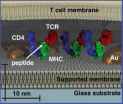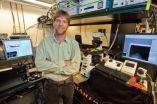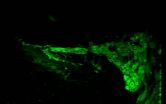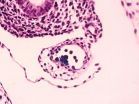(Press-News.org) Using nanodot technology, Berkeley Lab researchers have demonstrated the first size-based form of chromatography that can be used to study the membranes of living cells. This unique physical approach to probing cellular membrane structures can reveal information critical to whether a cell lives or dies, remains normal or turns cancerous, that can't be obtained through conventional microscopy.
"We've developed membrane-embedded nanodot array platforms that provide a physical means to both probe and manipulate membrane assemblies, including signaling clusters, while they are functioning in the membrane of a living cell," says Jay Groves, a chemist with Berkeley Lab's Physical Biosciences Division, who led this research.
Groves, who is also a professor with the University of California (UC) Berkeley's Chemistry Department, and a Howard Hughes Medical Institute (HHMI) investigator, is a recognized leader in developing techniques for studying the impact of spatial patterns on living cells. The live-cell supported synthetic membranes he and his group have been developing are constructed out of lipids and assembled onto a substrate of solid silica. These membranes are being used to determine how living cells not only interact with their environment through chemical signals but also through physical force and spatial patterns.
"We call our approach the spatial mutation strategy because molecules in a cell can be spatially re-arranged without altering the cell in any other way," Groves says. "Our live cell-supported membranes provide a hybrid interface consisting of mobile and immobile components with controlled geometry that allows us to utilize solid-state nanotechnology to manipulate and control molecular systems inside living cells."
While the work of Groves and others in recent years has demonstrated the importance of protein and lipid spatial organization within cellular membranes, details as to how spatial organization is tied to function are scarce primarily because of the limitations of optical microscopy at length scales below the 250 nanometer diffraction limit. The size-based chromatography technique developed by Groves and his group allows them to probe supramolecular structures in a cell membrane at the needed nanometer length-scales.
"We now have a way to translate nano-sized structures that approach molecular dimensions into geometric constraints on the movement of molecules inside a living cell," Groves says.
For their size-based chromatography technique, the spacing of proteins and other cellular molecules is controlled by a hexagonal or honeycomb array of gold nanoparticles that is fabricated into the membrane. The spacing between nanoparticles in each array can be controlled, with accessible sizes ranging from 30 to nearly 200 nanometers.
"Individual membrane components move freely throughout the array, but movement of larger assemblies is impeded if they exceed the physical dimensions of the array, Groves says.
Groves and his colleagues tested their size-based chromatography technique on T cell receptor (TCR) microclusters in T cell membranes, which is the functional module for antigen recognition by T cells (lymphocytes from the thymus) in the body's immune response system. These TCR signaling clusters occupy a size regime ranging from tens to a few hundred nanometers, which is typically below the diffraction limit of conventional optical microscopy. Size-based chromatography was used to probe the physical properties of TCR signaling clusters as a function of antigen density. The results revealed that TCR signaling cluster is distinctly dependent on the amount of antigen encountered by the cell.
"This is something we did not know before about the TCR microcluster signaling system, which has been well-studied using conventional optical microscopy," Groves says. "It is a proof-of-principle demonstration that represents another step in the direction of interfacing living cells with synthetic materials to achieve molecular level control of the cell."
INFORMATION:
A paper on this research has been published in NANO Letters. The paper is titled "Size-based chromatography of signaling clusters in a living cell membrane." Groves is the corresponding author. Others authors are Niña Caculitan, Hiroyuki Kai, Eulanca Liu, Nicole Fay, Yan Yu, Theobald Lohmüller and Geoff O'Donoghue.
Lawrence Berkeley National Laboratory addresses the world's most urgent scientific challenges by advancing sustainable energy, protecting human health, creating new materials, and revealing the origin and fate of the universe. Founded in 1931, Berkeley Lab's scientific expertise has been recognized with 13 Nobel prizes. The University of California manages Berkeley Lab for the U.S. Department of Energy's Office of Science. For more, visit http://www.lbl.gov.
First size-based chromatography technique for the study of living cells
2014-04-23
ELSE PRESS RELEASES FROM THIS DATE:
Hearing quality restored with bionic ear technology used for gene therapy
2014-04-23
VIDEO:
This shows regenerated auditory nerves, after gene therapy.
Click here for more information.
Researchers at UNSW Australia have for the first time used electrical pulses delivered from a cochlear implant to deliver gene therapy, thereby successfully regrowing auditory nerves.
The research also heralds a possible new way of treating a range of neurological disorders, including Parkinson's disease, and psychiatric conditions such as depression through this novel way of delivering ...
Study shows aspirin can reduce colorectal cancer risks for those with specific gene
2014-04-23
The humble aspirin may have just added another beneficial effect beyond its ability to ameliorate headaches and reduce the risk of heart attacks: lowering colon cancer risk among people with high levels of a specific type of gene.
The extraordinary finding comes from a multi-institutional team that analyzed data and other material from two long-term studies involving nearly 128,000 participants. The researchers found that individuals whose colons have high levels of a specific gene product — 15-hydroxyprostaglandin dehydrogenase (15-PGDH) RNA — dramatically reduce their ...
Atomic switcheroo explains origins of thin-film solar cell mystery
2014-04-23
OAK RIDGE, Tenn., April 23, 2014 — Treating cadmium-telluride (CdTe) solar cell materials with cadmium-chloride improves their efficiency, but researchers have not fully understood why. Now, an atomic-scale examination of the thin-film solar cells led by the Department of Energy's Oak Ridge National Laboratory has answered this decades-long debate about the materials' photovoltaic efficiency increase after treatment.
A research team from ORNL, the University of Toledo and DOE's National Renewable Energy Laboratory used electron microscopy and computational simulations ...
Economics = MC2 -- A portrait of the modern physics startup
2014-04-23
WASHINGTON D.C., April 23, 2014 -- For much of the 20th century, many of the technological innovations that drove U.S. economic growth emerged from "idea factories" housed within large companies -- research units like Bell Labs or Xerox PARC that developed everything from the transistor to the computer mouse.
In recent decades, however, many large high-tech companies have eliminated in-house research programs, turning instead to startup companies as their primary source of breakthrough innovations.
"Small startups have replaced corporate research centers as the drivers ...
Pollutants from coal-burning stoves strongly associated with miscarriages in Mongolia
2014-04-23
Burning coal for domestic heating may contribute to early fetal death according to a new study by experts from The Saban Research Institute of Children's Hospital Los Angeles and Ulaanbaatar, Mongolia – the coldest capital city in the world.
In a paper published today in the journal BMC Pregnancy and Childbirth, researchers report
"alarmingly strong statistical correlations" between seasonal ambient air pollutants and pregnancy loss in Ulaanbaatar (UB), Mongolia.
UB has one of the highest levels of air pollution of all world capitals, with sulfide dioxide and particulate ...
Superconducting qubit array points the way to quantum computers
2014-04-23
A fully functional quantum computer is one of the holy grails of physics. Unlike conventional computers, the quantum version uses qubits (quantum bits), which make direct use of the multiple states of quantum phenomena. When realized, a quantum computer will be millions of times more powerful at certain computations than today's supercomputers.
A group of UC Santa Barbara physicists has moved one step closer to making a quantum computer a reality by demonstrating a new level of reliability in a five-qubit array. Their findings appear Thursday in the journal Nature.
Quantum ...
Cyber buddy is better than 'no buddy'
2014-04-23
A Michigan State University researcher is looking to give exercise enthusiasts the extra nudge they need during a workout, and her latest research shows that a cyber buddy can help.
The study, which appears in the Games for Health Journal, is the first to indicate that although a human partner is still a better motivator during exercise, a software-generated partner also can be effective.
"We wanted to demonstrate that something that isn't real can still motivate people to give greater effort while exercising than if they had to do it by themselves," said Deborah Feltz, ...
Male or female?
2014-04-23
This news release is available in French and German. Man or woman? Male or female? In humans and other mammals, the difference between sexes depends on one single element of the genome: the Y chromosome. It is present only in males, where the two sexual chromosomes are X and Y, whereas women have two X chromosomes. Thus, the Y is ultimately responsible for all the morphological and physiological differences between males and females.
But this has not always been the case. A very long time ago, the X and Y were identical, until the Y started to differentiate from the ...
Hundreds of genetic mutations found in healthy blood of a supercentenarian
2014-04-23
April 23, 2014 – Genetic mutations are commonly studied because of links to diseases such as cancer; however, little is known about mutations occurring in healthy individuals. In a study published online in Genome Research, researchers detected over 400 mutations in healthy blood cells of a 115-year-old woman, suggesting that lesions at these sites are largely harmless over the course of a lifetime.
Our blood is continually replenished by hematopoietic stem cells that reside in the bone marrow and divide to generate different types of blood cells, including white blood ...
From liability to viability: Genes on the Y chromosome prove essential for male survival
2014-04-23
CAMBRIDGE, Mass. (April 23, 2014) – Despite a well-documented history of dramatic genetic decay, the human Y chromosome has over the course of millions of years of evolution managed to preserve a small set of genes that has ensured not only its own survival but also the survival of men. Moreover, the vast majority of these tenacious genes appear to have little if any role in sex determination or sperm production.
Taken together, these remarkable findings—published this week in the journal Nature—suggest that because these Y-linked genes are active across the body, they ...








